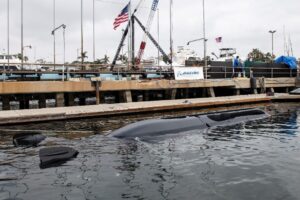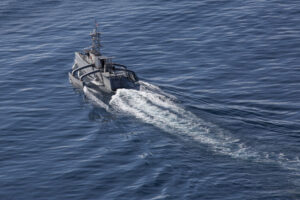A top Marine Corps official recently said the service is looking to deploy loitering munitions off on unmanned vessels, but the capability has not been tested yet.
Speaking during the Defense News Conference on Sept. 6, Lt. Gen. Karsten Heckl, Deputy Commandant for Combat Development and Integration, said the service is focusing on organic precision fires and loitering munitions. He said the service thinks they can accelerate development of those kinds of systems because industry is further ahead than the military.

“The idea of loitering munitions coming off of unmanned surface vessels [USV], loitering munitions coming out of unmanned underwater vessels [UUV], you can let your imagination run wild. We’re pushing the envelope on all of those. Right now I’m working on getting a light version for our dismounted infantry and we’re pushing pretty hard with that,” Heckl said.
He told reporters after his event discussion that while the Marine Corps is “not experimenting, but we will” with using UUVs and USVs, he outlined a potential scenario.
“I mean imagine maybe it’s even a semi-submersible. So if you don’t have to go deep in the water it’s less expensive, just not as complicated, but imagine a fully autonomous UUV that can go out, get to within X range of an area, surface and launch thousands of loitering munitions that are fully autonomous, and then slip back below the surface and return to an [expeditionary advanced base] to be refilled. That’s where we’re going with this.”
Heckl did not confirm what size UUVs the service is looking at, but said they are “certainly looking” at the Boeing [BA] Orca Extra-Larch Unmanned Undersea Vehicle for this capability and possibly semi-submersibles

He said he tries to reduce the costs of everything he works on and so they do not need a submersible that costs more to go down to a nuclear submarine depth.
“Just don’t need it, it’s very expensive, So that’s why the semi-submersible thing is really attractive,” Heckl told reporters.
He also said there is a “lot of potential” in launching torpedoes from USVs.
“Why can’t I launch Mark 48 torpedoes and kill ships, really kill them, that’s the most effective killer. So we’re looking at that.”